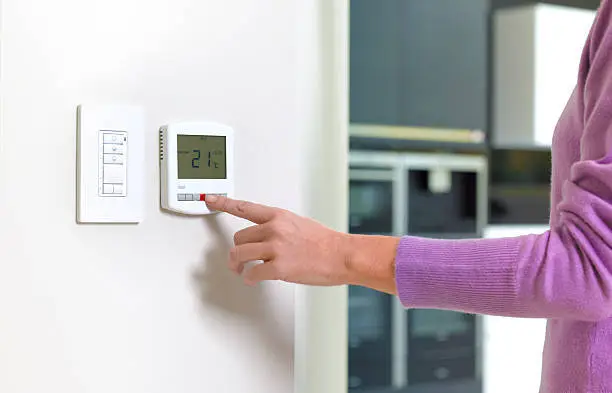
Table of Contents
Maintaining the right room temperature is crucial for comfort and health. Whether it’s the middle of a harsh Canadian winter or the height of summer, knowing the ideal indoor temperature can significantly impact your well-being. In this article, we’ll explore the best temperatures for different rooms, the benefits of maintaining these temperatures, and practical tips for achieving and maintaining the ideal climate in your home or office.
Ideal Room Temperature for Different Rooms
Every room in your home has a different purpose, and the ideal temperature can vary accordingly.
Living Areas
For living rooms and common areas where you spend a lot of time relaxing and socializing, the ideal temperature is typically between 20°C and 22°C (68°F to 72°F). This range strikes a balance between comfort and energy efficiency, ensuring the space is neither too warm nor too cool.
Bedrooms
Bedrooms often require a slightly cooler temperature to promote better sleep. Experts recommend setting your thermostat between 16°C and 18°C (60°F to 65°F) during sleeping hours. Cooler temperatures help your body cool down and prepare for sleep, leading to more restful and uninterrupted sleep cycles.
Kitchens
Since cooking appliances generate heat, kitchens can be slightly warmer than other areas. Keeping the temperature around 20°C (68°F) helps offset the additional heat from cooking and keeps the environment comfortable without overloading your cooling system.
Home Offices and Workspaces
For home offices and workspaces, maintaining a temperature around 21°C (70°F) is ideal. This temperature supports focus and productivity, ensuring you remain comfortable without feeling too warm, which can lead to drowsiness, or too cold, which can be distracting.
Children’s Rooms and Elderly Care Spaces
Rooms used by children and elderly individuals might require a bit more warmth. Aim for a temperature between 22°C and 23°C (72°F to 73°F) to ensure a comfortable environment. These groups are more sensitive to temperature fluctuations, so a slightly warmer setting can help prevent discomfort and health issues.
Room Type | Ideal Temperature (°C) | Ideal Temperature (°F) | Notes |
|---|---|---|---|
Living Areas | 20°C to 22°C | 68°F to 72°F | Balances comfort and energy efficiency, suitable for relaxing and socializing. |
Bedrooms | 16°C to 18°C | 60°F to 65°F | Promotes better sleep by helping the body cool down and prepare for restful sleep cycles. |
Kitchens | Around 20°C | Around 68°F | Compensates for additional heat from cooking appliances, maintaining comfort without overload. |
Home Offices and Workspaces | Around 21°C | Around 70°F | Supports focus and productivity, avoiding discomfort from being too warm or too cold. |
Children’s Rooms and Elderly Care Spaces | 22°C to 23°C | 72°F to 73°F | Ensures a comfortable environment for sensitive groups, preventing discomfort and health issues. |
In our previous guide, you will find more about the ideal room temperature in Canada. https://thehvacservice.ca/what-are-the-ideal-indoor-temperatures-in-canada/
Benefits of Maintaining Optimal Temperature

Maintaining the ideal room temperature offers numerous benefits beyond just comfort.
A comfortable indoor temperature can significantly impact your health. Proper temperature regulation helps improve sleep quality, supports concentration, and can even enhance mood. Additionally, maintaining a consistent indoor temperature helps reduce the risk of respiratory issues and minimizes the likelihood of developing mold and mildew, which thrive in excessively damp or cold environments.
Keeping your home at the right temperature can also lead to significant energy savings. Heating and cooling systems account for a substantial portion of household energy use. By optimizing your thermostat settings, you can reduce energy consumption and lower your utility bills. For instance, lowering the thermostat by just 1°C during winter can save up to 5-10% on heating costs.
For a professional air conditioner maintenance in Canada, reach out to HVAC Service Solutions via the link below.
Tips for Maintaining Healthy Room Temperature
Achieving and maintaining the ideal temperature in your home or office involves more than just setting the thermostat. Here are some practical tips to help you create the perfect indoor climate.
Use Smart Thermostats
Smart thermostats are a great investment for maintaining the ideal temperature. These devices allow you to program temperature settings based on your schedule, adjust settings remotely, and even learn your preferences over time to optimize heating and cooling automatically. Features like geofencing can adjust the temperature when you’re away, ensuring energy isn’t wasted on heating or cooling an empty home.
Seasonal Adjustments
Adjusting your thermostat settings based on the season can help maintain comfort and efficiency. In the winter, aim for a slightly lower indoor temperature and wear warmer clothing or use blankets to stay cozy. During the summer, keep the temperature a bit higher and use fans to circulate air, making the space feel cooler without over-relying on air conditioning.
Proper Insulation
Good insulation is key to maintaining a stable indoor temperature. Ensure your home is well-insulated to prevent heat loss in the winter and keep cool air inside during the summer. This includes insulating walls, ceilings, and floors, as well as sealing windows and doors to prevent drafts.
Regular HVAC Maintenance
Regular maintenance of your heating, ventilation, and air conditioning (HVAC) system is essential for optimal performance. Schedule annual check-ups with a professional HVAC service to ensure your system is running efficiently and to address any issues before they become major problems. Clean or replace filters regularly to maintain good air quality and system efficiency.
Use of Fans and Ventilation
Fans and proper ventilation can help distribute air more evenly throughout your home, reducing the load on your HVAC system. Ceiling fans, for instance, can be used to circulate warm air in the winter by running them clockwise at a low speed, pushing warm air down from the ceiling. In the summer, running fans counterclockwise creates a cooling breeze.
Conclusion
The ideal room temperature plays a significant role in ensuring comfort, health, and energy efficiency in your home or office. By understanding the optimal temperatures for different rooms and implementing practical tips to maintain these temperatures, you can create a more comfortable and efficient living environment.
Choosing HVAC Service Solutions to help manage your heating and cooling needs ensures you receive professional advice and services tailored to your specific requirements. Our expert team can assist you in selecting the right systems, maintaining them for optimal performance, and making the necessary adjustments to achieve the perfect indoor climate year-round.
Contact us today via the link below, and we will be happy to help you.
Frequent Asked Questions
What is considered the ideal temperature for living areas?
The ideal room temperature for living areas such as living rooms and family rooms is typically between 20°C and 22°C (68°F to 72°F). Maintaining this range ensures a comfortable environment for everyday activities like relaxing, reading, or watching TV. A healthy room temperature within this range can also help prevent overheating or feeling too cold, contributing to overall well-being. Additionally, keeping a consistent room temperature in Fahrenheit around 68°F to 72°F can help save on energy bills by avoiding excessive heating or cooling. This balance is crucial, especially during the extreme weather conditions often experienced in Canada. Ensuring your living areas have an ideal room temperature can make your home a cozy retreat.
What temperature is best for bedrooms to ensure good sleep?
For the best sleep quality, the recommended healthy room temperature for bedrooms is between 16°C and 18°C (60°F and 65°F). This slightly cooler range helps your body cool down naturally, which is essential for falling and staying asleep. Studies have shown that a room temperature in Fahrenheit of around 60°F to 65°F supports the body’s natural sleep processes, leading to deeper and more restorative sleep. Maintaining an ideal room temperature in your bedroom can prevent disturbances such as night sweats or waking up too cold. This is especially important for those with sleep disorders or sensitivities to temperature changes. A consistent, cool room temperature can make a significant difference in sleep quality and overall health.
What is the optimal temperature for kitchens?
Kitchens often generate additional heat from cooking appliances, so maintaining an ideal room temperature around 20°C (68°F) is optimal. This room temperature in Fahrenheit ensures that the kitchen remains comfortable without feeling overly warm while you cook and dine. A healthy room temperature in the kitchen can also prevent the HVAC system from overworking to balance the heat generated by stoves, ovens, and other appliances. This can be particularly beneficial in maintaining energy efficiency in your home. Keeping the kitchen at a consistent room temperature also helps with food storage and preparation, ensuring a safe and pleasant cooking environment. In summary, a room temperature of around 68°F strikes a balance between comfort and functionality in the kitchen.
What temperature should be maintained in home offices?
Home offices and workspaces should ideally be kept at around 21°C (70°F) to ensure comfort and productivity. This room temperature in Fahrenheit provides a comfortable working environment that helps maintain focus and efficiency throughout the workday. An ideal room temperature for workspaces prevents discomfort that can arise from being too cold or too warm, which can distract from tasks at hand. Additionally, a healthy room temperature in your home office can improve concentration and reduce fatigue, leading to better performance and work output. It’s important to create a conducive work environment, especially for those who work from home regularly. Maintaining a consistent room temperature also helps protect electronic equipment from overheating or malfunctioning.
What is the most suitable temperature for children’s rooms and elderly care spaces?
rooms occupied by children and elderly individuals, a healthy room temperature between 22°C and 23°C (72°F and 73°F) is recommended. This slightly warmer range ensures a comfortable environment for those who are more sensitive to temperature fluctuations. Maintaining this ideal room temperature helps prevent health issues such as colds or respiratory problems that can arise from being too cold. A room temperature in Fahrenheit of around 72°F to 73°F provides a cozy and safe space for children to play and sleep, and for elderly individuals to rest and stay active. This consistency in room temperature is particularly important during the colder months in Canada, where extreme temperatures can affect vulnerable populations. Ensuring a stable and warm room temperature can significantly enhance comfort and health for children and elderly family members.
What are the benefits of maintaining the optimal indoor temperature?
Maintaining an optimal indoor temperature offers numerous benefits for health and comfort. A healthy room temperature supports better sleep quality, as a cooler bedroom helps regulate the body’s sleep cycle. An ideal room temperature in living areas enhances concentration and mood, creating a more pleasant environment for daily activities. Keeping a consistent room temperature in Fahrenheit around 68°F to 72°F can also reduce the risk of respiratory issues by preventing mold growth and maintaining good air quality. Additionally, optimizing room temperature settings can lead to significant energy savings, as it reduces the need for excessive heating or cooling. This balance not only lowers utility bills but also reduces the environmental impact of your home. Overall, a healthy room temperature promotes well-being and sustainability.
How can a thermostat help in maintaining the right temperature?
A smart thermostat is a valuable tool for maintaining the ideal room temperature throughout your home. These devices allow you to program temperature settings based on your daily schedule, ensuring a healthy room temperature is maintained even when you are not home. Smart thermostats can adjust the room temperature in Fahrenheit to your preferences automatically, optimizing comfort and energy efficiency. Features such as remote control and learning capabilities make it easier to achieve and maintain the ideal room temperature. For instance, they can lower the heating when you’re away and warm the house just before you return, ensuring you always walk into a comfortable environment. Additionally, smart thermostats provide insights into your energy usage, helping you make more informed decisions about your heating and cooling habits. Investing in a smart thermostat is an excellent way to ensure a consistent and healthy room temperature.
How should I adjust the temperature based on the season?
Adjusting your thermostat settings according to the season is crucial for maintaining a healthy room temperature and optimizing energy use. In the winter, lowering the thermostat by a few degrees and using blankets or warm clothing can help maintain a comfortable environment while saving on heating costs. Conversely, in the summer, keeping the room temperature in Fahrenheit slightly higher and using fans can help circulate cool air and reduce the load on your air conditioning system. Seasonal adjustments ensure that you maintain an ideal room temperature without overworking your HVAC system. It’s also beneficial to program your thermostat to lower the temperature at night during winter for better sleep and to raise it slightly during the day in summer when the house might be empty. These small adjustments can lead to significant energy savings and a more comfortable living environment year-round.
Why is regular HVAC system maintenance important?
Regular maintenance of your HVAC system is essential for maintaining a healthy room temperature and ensuring the system’s efficiency. Scheduled check-ups help identify and fix issues before they become major problems, preventing unexpected breakdowns and costly repairs. A well-maintained HVAC system can consistently maintain the ideal room temperature in all areas of your home, contributing to overall comfort and well-being. Regular filter changes and cleaning improve indoor air quality, reducing allergens and pollutants. Ensuring that your HVAC system is in good working order also enhances its energy efficiency, saving you money on utility bills. By keeping the system running smoothly, you can achieve a stable room temperature in Fahrenheit throughout the year. Investing in regular maintenance extends the lifespan of your HVAC system and ensures it performs optimally, providing a healthy and comfortable indoor environment.
What measures can be taken to improve home insulation?
Improving home insulation is key to maintaining a consistent and healthy room temperature. Proper insulation helps prevent heat loss in the winter and keeps cool air inside during the summer, making it easier to maintain the ideal room temperature. Insulating walls, ceilings, and floors can significantly enhance energy efficiency and comfort. Additionally, sealing gaps and cracks around windows and doors prevents drafts, further stabilizing the room temperature in Fahrenheit. Upgrading to double or triple-pane windows can also improve insulation and reduce energy costs. Using weatherstripping and door sweeps can help block out unwanted cold air in winter and hot air in summer. Ensuring your home is well-insulated not only maintains a healthy room temperature but also reduces the load on your HVAC system, extending its lifespan and improving its performance.
Share



















